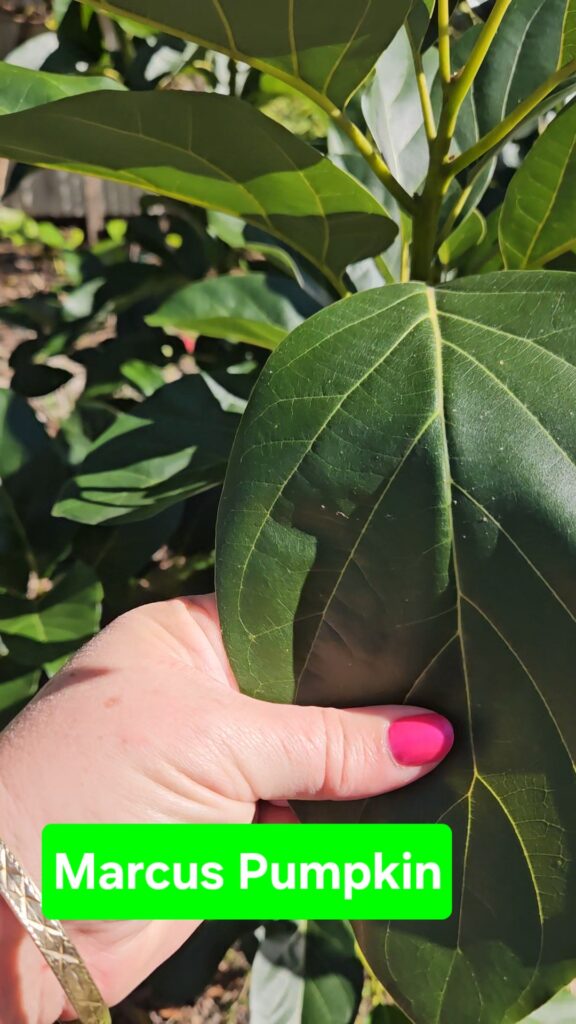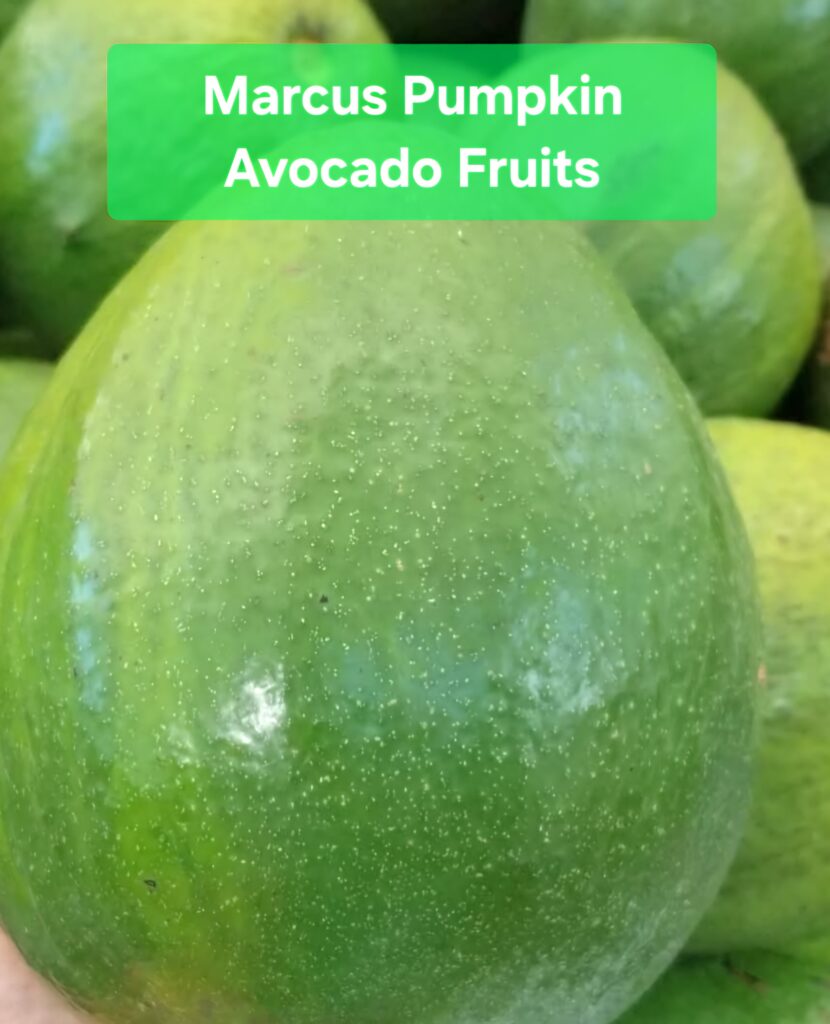Growing Marcus Pumpkin Trees in the Northeast Florida Landscape
Marcus Pumpkin / Persea americana Origins:
– Marcus Pumpkin is a Guatemalan / West Indian Hybrid Avocado tree with Type B Flowering schedule. It is one of the largest avocado varieties available in Florida and the big green round fruits can weigh up to three pounds!
Marcus Pumpkin Avocado Tree Exposure:
– Marcus Pumpkin avocado trees should be planted into a full sun or afternoon sun location in the Northeast Florida landscape.
Marcus Pumpkin Foliage and Winter Tolerance:
– Large light to medium green foliage, non scented. Remains evergreen in the winter.
Marcus Pumpkin avocado trees have a high cold tolerance known to survive winter temperatures in the as low as 20°F.
Marcus Pumpkin Soil Preference / Salt tolerance:
-Avocado trees need well drained soils. They are not tolerant of overly moist soils, avoid planting in areas that remain wet for days after heavy rains, plant in raised beds or berms in areas with a high water table. when planted into well drained soils avocados are well suited to the native sandy soils of Florida and do not require amendment at the time of planting.
– low salt tolerance not suitable for coastal gardens.
Marcus Pumpkin Avocado Size Variance and Growth Habit:

Marcus Pumkin avocado trees are large and fast growing selection that will reach 25-30 ft high and have a strongly upright habit. They will produce fruit best when kept to an open center by removing the central leader where sunlight can penetrate into the branch structure. This helps keep the trees fruit where you can easily reach it, keeps get sunlight and air circulation into the inner branch structure and helps with any pest / leaf treatments you may need.
Marcus Pumpkin Avocado Tree Growth Rate:
– Avocado trees are considered a moderate to fast growing plant selection. Once established into the landscape expect 1-3 ft of foliage growth in a season. Marcus Pumpkin avocado is going to be on the faster side of that range.
Marcus Pumpkin Avocado Tree Blooms and Fruit:
Marcus Pumpkin avocado trees follow the type B flowering schedule that open as female in the afternoon of the first day, remain open for 2-4 hours and close late that afternoon. Those same flowers will then reopen as male in the morning of the second day.
– Marcus Pumpkin avocados are grown for their huge round fruits that can weigh as much as 3 lbs! They have a bumpy thick green skin with a large round pit in the center. They have a high oil content and a smooth texture with mild flavor. They are considered a light bearing tree, presumably because the tree needs so much energy to produce those much larger fruits so it will not have as many. It is still and excellent variety with plenty of fruit for home production.
All avocado fruit ripens once it has fallen from the tree or has been picked. Once your Marcus Pumpkin avocado tree fruit has reached mature size and changed from the bright green skin to a deeper darker green you can pick them and let them ripen indoors at will or leave them on the tree until you need them! If the fruit wrinkles up after letting them sit to to ripen the fruit was not finished maturing, leave them on the tree longer and try harvesting one again in a few weeks.
Begin harvesting your Marcus Pumpkin avocado tree from October to November here in Northeast Florida.
Avocado Water Requirements:
– Although much more durable once established in the landscape, regular water is necessary to get the plant rooted and growing on its own after being planted in the ground from an S & J Nursery container. Use supplemental irrigation when planted in full sun or in extremely sandy soil.
– Water generously during droughts at least once or twice a week for best results if
planted into an non irrigated garden location.
Care of Marcus Pumpkin Avocado Trees in the Northeast Florida Landscape:
– Its always best to trim an avocado just after harvesting. With later blooming and later harvesting varieties you may want to wait until spring to do any trimming and shaping to avoid new growth sprouting before a freeze after pruning. It wont be the end of the world if that happens you may just end up having to do a little cleanup pruning in the spring on leaves or stems that didn’t make it. Make sure to fertilize at the same time you prune and water well for the next few weeks to ensure the tree has everything it needs to get growing.
– Avocado trees will need good water during the establishment period and
supplemental irrigation during dry spells or particularly hot dry summers, especially when planted into sandy soils.
– Fertilize your newly planted trees every other month through the year with a good tropical plant food or a slow release poly coated plant food such as Osmocote. This is especially important on newly planted and younger trees. Once the trees are well established and have been growing for a few years in your landscape you can reduce that to once a season, or 4 times a year.
– Keep the area below the foliage free of grass and other vegetation that will compete for nutrients. Mulch thickly in a circle around the tree under the foliage canopy being sure to keep it thinner not letting it pile up right at the base of the trunk. Start with at least a 4 ft wide circle on a young tree and you can keep expanding the mulch bed area to the foliage line as your tree grows. Arborist chips are ideal, you can also use other options like leaf litter from surrounding landscape trees, pine straw or pine bark all good sustainable options that will both help regulate soil moisture and break down into nutrition for your trees.

Bacon Avocado | Hardy to 24-26°F
Brazos Belle | Hardy to 15-18°F
Brogden Avocado | Hardy to 15°F
Choquette | Hardy to 22°F
Fantastic | Hardy to 15°F
Florida Haas | Hardy to 18°F
Fuerte Avocado | Hardy to 26° F
Hall Avocado | Hardy to 20°F
Joey Avocado | Hardy to 15°F
Lila Avocado | Hardy to 15°F
Lula Avocado | Hardy to 25°F
Marcus Pumpkin | Hardy to 20°F
Mexicola Grande | Hardy to 18°F
Monroe | Hardy to 25°F
Nishikawa Avocado | Hardy to unknown 25-28° F
Oro Negro Avocado | Hardy to 25-28°F rumor has it much lower
Pancho Avocado | Hardy to 15°F
Thompson Red | Hardy to 24°F
Winter Mexican Avoacado | Hardy to 18°F
Wurtz Avocado | hardy to 24°F

